 loading
loading
featuresWhat they're making at the “maker space”Students and recent grads show off their projects from the Center for Engineering Innovation and Design. Alan Wechsler, a freelancer in upstate New York, has written for the New York Times, the Atlantic, and other publications. He has never invented anything, but he did manage to get his snowblower working again. 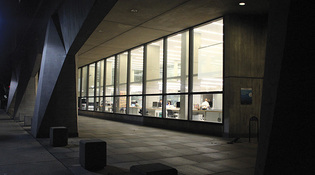 Mark Zurolo ’01MFAThe five-year-old “maker space” on Prospect Street is a campus hub for invention. With more than 5,000 current and former members, the space offers a collaborative community, along with tools of trade ranging from rubber bands to heavy machinery. View full imageIt’s a quiet Monday evening in Yale’s Center for Engineering Innovation and Design, which is to say, nobody today has won a patent, designed a new musical instrument, created a new technology, or launched a business. But give them time. It’s still early. The students in the Wet Lab are trying to design a device to dry soil samples quickly for testing. Downstairs, a student is using a computer assisted drawing program to design props for a new play. At the other end of the room, a hundred students are sitting—or standing, or perching on a stairway—to hear a Nintendo engineer talk about a computer nerd’s dream job. Welcome to the CEID, an 8,700-square-foot “maker space” and design lab in the heart of the Yale campus. Envisioned and shepherded by outgoing engineering dean Kyle Vanderlick and funded by alumni, the CEID was created to instill a culture for engineering at Yale—and to encourage Yale students not only to think outside the box, but even, if it’s called for, to invent a whole new box. The CEID opened in 2012 on Prospect Street, in the former engineering library. To call it successful is to put it mildly; today, there are more than 5,000 current and former members. “This is a real community,” says Vince Wilczynski, deputy dean of the School of Engineering and Applied Science and director of the CEID. “It’s a space where you definitely see another culture—one of people collaborating, one of people applying technology to solve problems, one of friendship.” A walk through the center quickly illustrates the breadth of activities. One workstation holds bins filled with pom-poms, pipe cleaners, tape, Legos, and rubber bands. Dozens of hand tools are hanging on a wall. One of the many 3-D printers is slowly giving birth to a project of indeterminate nature—5 percent complete, with 12 hours and 43 minutes to go, according to the readout. Nearby locked rooms contain the heavy stuff: shop equipment for woodworking and metalworking, plus a laser cutter. Safety and security requirements are strictly enforced. Access to the equipment requires training and authorization. Members don’t need to be engineers. In fact, fewer than half of them have STEM-focused majors; more are “yet to decide,” or are social science or humanities students, says Wilczynski. To become a member, anyone in the Yale community can do the training online, pass an exam, and attend an orientation session. As for recruitment, the center advertises itself: the side fronting the street features a 75-foot-long wall of windows, 14 feet high. Passersby constantly peer in. The space is home to a variety of activities, from a welcome party at the start of every academic year—“we have people dancing in the engineering building,” notes Wilczynski—to hackathons and tech talks. Nearly a dozen Yale student clubs use the space, including a group that builds rockets for fun and research and a group called Bulldogs Racing, whose members design competitive race cars. A number of classes are taught, on such wide-ranging topics as sustainable design and the design of musical instruments. Many students join in their first year and stay active for their entire Yale career. Some say the space is what brought them here. One such is Bryan Duerfeldt ’17, now 24, who lives in New Haven and works for a Yale-birthed start-up called ARIX Technologies, which is designing a robot to test industrial pipes for contamination. The technology, of course, was invented at the CEID. For a glimpse of ARIX and more, read on. 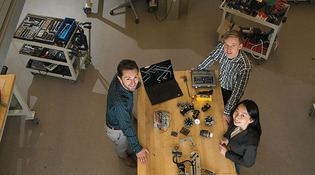 Julie BrownDianna Liu ’18MBA teamed with Bryan Duerfeldt ’17 (left) and Petter Wehlin ’17 to build a compact robot capable of traveling along pipes and finding problem spots before they lead to bigger problems. View full imagePipe dreamAt about 6:15 p.m. on August 6, 2012, fire erupted at the Chevron Richmond Refinery on San Francisco Bay in California. The flames burned for four hours, sending 15,000 nearby residents to the hospital for smoke inhalation. The cause was later reported to be a pipe that had been damaged by corrosion. Dianna Liu ’18MBA is working with two Yale engineering graduates to build a robot that might help prevent incidents like this. The compact robot, equipped with opposable wheels, would travel along pipes in refineries, ships, chemical plants, water treatment plants, and other industrial sites where access is difficult. Fitted with sensing equipment or cameras, the robot could spot signs of distressed metal before failure occurs. “A lot of these pipes are underground; they’re surrounded by other pipes; they’re closely laid out; there’s obstacles in the way,” Liu says. Manual inspection “is difficult and expensive and dangerous. There are thousands of pipes per refinery.” Liu, 28, a Texas native, spent three years working for ExxonMobil. That was where she started thinking about this project—and was amazed to find no one else had invented it. She left her job to do just that at Yale. “I thought, ‘Why not give it a shot? It doesn’t seem insurmountable. If I don’t try it, I’m going to regret not trying.’” Once at Yale, Liu started searching for partners. She met engineering students Bryan Duerfeldt ’17 and Petter Wehlin ’17 and hired them with seed money—her own savings. Later, the tiny start-up won grants through the university: Yale’s Miller Prize, and a summer fellowship for Liu at the Yale Entrepreneurial Institute. The team spent many hours at the CEID, discussing their project with staff, using their laptops to design a device, and building prototypes. “It was the perfect place for us to do this work,” Duerfeldt says. “We got all sort of interesting feedback and guidance from literally everyone.” They took three months to come up with a working model that could crawl across pipes in tight spaces, turn corners, and not be blocked by supports. Today, ARIX Technologies has been formally incorporated and has applied for two provisional patents. The team is now working with “industry players” to fine-tune the design. They’ve got a number of advisers and are seeking investors, as well as more engineers. And the market potential for their invention could be huge: Liu says US petrochemical refineries alone spend billions of dollars every year to prevent damage from corrosion. 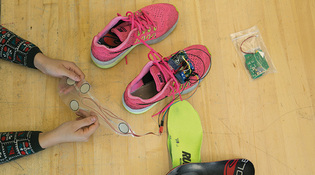 Julie BrownView full image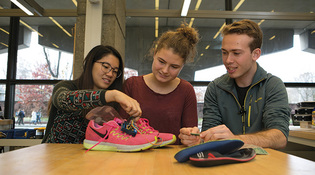 Julie BrownJoyce Duan ’20, Lauren Chapey ’20, and Ethan O’Reilly ’20 (left to right) created an insert for running shoes to help avoid injuries. View full imageSaving your feetHow did three eighteenth-century German princesses help in producing a device that may someday help prevent runners’ foot injuries? Lauren Chapey ’20 first saw the CEID on a campus tour while she was in high school. In her first year at Yale, she signed up for Introduction to Engineering and Design, which is taught at the center. There she met Ethan O’Reilly ’20, an expert in mechanics, and Joyce Duan ’20, a computer science and coding wonk. The three students (and a fourth who later left for a study-abroad program) were asked to create an exhibit for the Yale Center for British Art, which was planning a show on the princesses—all of them highly educated German royals who had married into the British royal family and had sponsored leading scientists of the day, including Isaac Newton. The exhibit had to demonstrate Newton’s groundbreaking theories of light, and the team concocted a display that used a flashlight to send a beam of light through a mirror and a prism. “We loved working together,” Chapey says. “We asked, ‘How can we do something like this again?’” So they applied to the CEID’s Summer Design Fellowship program, which sponsors 10 to 15 students for an eight-week project. All three run—Chapey competes on Yale’s cross country and track and field teams, and O’Reilly and Duan are recreational runners—and, in the brunch meetings they held almost every Saturday before the program started, they decided on a project that would help their sport. Eighty percent of runners suffer from injury at some point in their careers, says Chapey, and improving one’s stride can help. They began by interviewing doctors and running-shoe store managers, but, Chapey says, “we practically lived in the CEID. We called it our home.” Eventually they developed a paper-thin electronic insert for the bottom of a running shoe. The device, which they call “Happy Feet,” registers pressure with four sensors and maps out the impact of the foot during each step. It sends the information via Bluetooth to an iOS app for analysis. “If you’re doing the wrong thing on a five-mile run, that’s roughly 5,000 wrong steps,” Chapey says. “Pounding over and over again [with] the same repetitive motion is how people can get injured. We hope detecting that, early, could alleviate these injuries.” Today, they still meet for brunch every Saturday. And they’re still perfecting Happy Feet; they’re hoping to make an app so advanced it could predict injuries. (They stress, however, that runners should get medical advice before making any self-diagnoses.) The team is seeking grants, entering engineering contests, and considering an independent study course to earn Yale credit for the project. “We want to continue working together and taking a stab at entrepreneurship,” Chapey says. “I wish I was two steps ahead” on the project, “so I could use it on myself and my friends.” 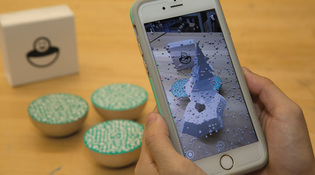 Julie BrownTeddy Mathias ’17MFA, a graphic designer, came up with a prototype for Deskfruit with two partners during a class at the CEID. His goal? To help people find their fun. “We want them to realize there’s room for magic,” says Mathias. View full image View full imageNow you see itDeskfruit is a wooden half-sphere, small enough to fit in your hand. It’s about the size and shape of a halved orange. The rounded part is unpainted wood, but the flat side is painted a bright aqua blue and patterned with white geometric shapes. Scan the pattern with an iPhone camera, and you’ll enter a new world. On the iPhone screen, you see all the ordinary reality that you know is in front of you—except . . . above the Deskfruit, something tantalizing and whimsical appears. It’s an image, three-dimensional, that you’ve chosen from the Deskfruit app: a squarish tree with snow falling around it, say, or a maze with a glowing marble. Move the Deskfruit, and the image moves with it. The snow falls. The maze tilts, so that you can move the marble around. Deskfruit has ambitions to be the new fidget spinner, maybe even the new yo-yo (you can play desk basketball on it). It runs on a technology known as augmented reality, and it’s for sale for $20 on Amazon. Inventor Teddy Mathias ’17MFA, a graphic designer, came up with the idea at the CEID. “When you hear of new technology, you can think of it as this complicated thing,” Mathias says. “We really want people to see it as a simple and playful object that gives people joy. We want them to realize there’s room for magic.” Mathias, now 31, took a roundabout path to Yale. After studying anthropology at Dartmouth, he spent several years playing bass in a band, Filligar, that includes his twin brother Pete on drums and younger brother Johnny on guitar and vocals. The group put out eight albums and was named cultural ambassadors by the US Department of State, visiting Mexico, Kuwait, Russia, and other countries. Teddy, who designed the band’s posters, eventually signed up for Yale’s three-year graduate program in graphic design. During his second year, he took a design course at the CEID called Making It. There, he and two partners came up with a Deskfruit prototype, and after class ended, Mathias continued pursuing the idea on his own. Today, Mathias is a full-time art director for an international client. Deskfruit is a side project, for which he’s partnered with his brother Pete. One early customer was the Getty Museum in Los Angeles, where Deskfruit is on sale in the gift shop. Thomas Stewart, who is in charge of developing merchandise for the Getty Stores, says the museum is working with Deskfruit to explore the potential for “a series of custom designs based on the museum’s permanent art collection.” 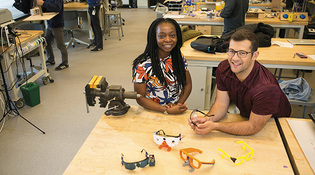 Julie BrownOyindamola Alliyu ’20 (left) and Antonio Medina ’19 wanted to help the seeing-impaired navigate. They came up with glasses that incorporate an integrated ultrasonic range finder. View full image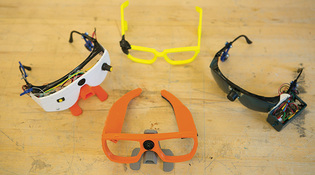 Julie BrownView full imageSeeing beyond the caneWhen Oyindamola Alliyu ’20 and Antonio Medina ’19 were paired for a recent CEID summer fellowship, they decided to work on a project that would help the blind get around on their own. At first they considered developing a “smart cane,” but many versions already exist. So they decided to find something better. As a first step, they consulted two experts. Phillip Magalnick and Honorata Kazmierczak are a middle-aged couple living in Stamford. They both have a degenerative retinal disease that reduces their vision to blurry shapes. Alliyu and Medina followed the couple around their neighborhood to learn how a blind person navigates. Using a cane takes practice. You learn to rely on sound and touch to determine your location and find obstacles you might trip over. It’s not a perfect system; Magalnick says he’s broken his nose three times and severely injured his knee on an unexpected curb cut. “The dishwasher door is my nemesis,” he adds. Alliyu and Medina imagined a device that could supplement the cane (or guide dog) by sensing any objects ahead and warning of potential dangers. “We spent a lot of time looking at the technologies” that already exist, recalls Medina. “We thought about something on the arm that could be worn, or maybe a necklace. We thought, ‘Where is the place where information is received that could be most accurate?’” “We didn’t want sensory overload. We wanted to make it simple and intuitive,” adds Alliyu. They settled on an ultrasonic range finder integrated into a pair of glasses. The sonar buzzes or beeps when it senses an object up to nine feet away, and the signals get more intense as the user moves closer to the obstruction. They’ve named their product “Variant Vision.” The two tried a variety of prototypes. Their working model was a hollow frame—created with CEID’s 3-D printer—with the electronics integrated inside. It was no fashion statement, but it worked: they tried it out themselves inside the CEID, blindfolded. The real test, though, was in Stamford. “It was pretty amazing,” recalls Magalnick, who tested the device in the garage of his apartment building and managed to avoid hitting the many support pillars. “We even detected the guy wires from telephone poles.” Alliyu and Medina aren’t done. They plan to keep improving the prototype. Magalnick has suggested, for instance, that the team consider making a device that clips onto a partially blind person’s existing glasses (which are often specialized and expensive). “I think they’re on the right path,” he says. 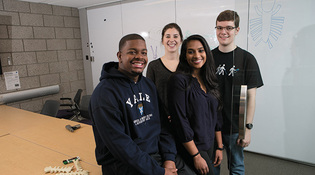 Julie BrownAaron Michael West ’18, Hanna Mandl ’17, Naoka Gunawardena ’18, and Connor McCann ’18 (top, left to right) created a saw guide for surgery inspired by a visit by two thoracic surgeons to their CEID class on medical devices. View full image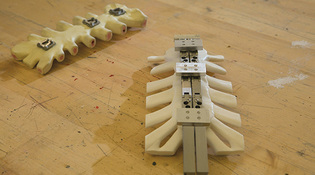 Julie BrownView full imageA better chest cutterHopefully, you’ll never need what Naoka Gunawardena ’18 and her partners built. The CEID class called Medical Device Design and Innovation begins with doctors from Yale New Haven Hospital giving presentations on medical problems they think might be improved with some clever engineering. When Gunawardena, Aaron Michael West ’18, Connor McCann ’18, and Hanna Mandl ’17 took the class, they heard Justin Blasberg and Tovy Kamine ’06, thoracic surgeons, describe the problems associated with splitting a chest. Chest surgery is brutally invasive. The skin is slit; a surgeon divides the sternum straight down the middle with a specialized medical saw; and the rib cage is pulled apart with a retractor. When the operation on the patient’s heart (or other organ) is complete, the halves of the sternum are reattached to each other with wires or metal plates. But if the surgeon doing the sawing deviates even slightly from the sternum’s center line, the resulting imperfect cut can cause complications, increase pain, add weeks to an expensive hospital stay, or even risk a patient’s life. About 700,000 of these surgeries are done each year in the United States. So—how to build a better chest cutter? The CEID team began by watching surgical videos. (YouTube has everything.) Then they designed a saw guide. It would be made of stainless steel. It would use hooks and a compass-like pivot for exact alignment. Once centered, it would be screwed firmly onto the sternum, giving the surgeon a straight, steady, and accurate line for cutting. The device could be split apart for retraction. And once the chest is closed and the device is removed, it would leave behind three plates, attached to each half of the sternum. These could be fastened together, uniting the halves of the sternum and ensuring a tight seal. It took 150 man-hours to machine-tool the device at the CEID and other Yale machine shops. The team hopes the device will someday be tested on a pig sternum or other bones similar to the human sternum, to test the efficacy of its design. “It has amazing potential,” says Blasberg. “They did a great job, considering it’s a single semester.” For Gunawardena, the project sealed her interest in the medical device industry. “This was great hands-on exposure—to be able to work with surgeons with this real-world problem,” she says. “And being able to come up with a solution.” 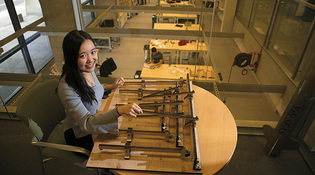 Julie BrownYuchen “Sophia” Dai ’20, a computer science and math major who sings and plays piano, violin, and Chinese flute, set out to recreate the sounds of a Chinese guzheng, a harp-like instrument. View full imageMusic + math = more musicThe challenge in the Musical Acoustics and Instrument Design class was to develop a completely new way to make music. Yuchen “Sophia” Dai ’20 developed an instrument she calls the “Trembling Twang.” Dai had one or two resources to draw on for the project: she’s a computer science and math major; she plays piano, violin, and Chinese flute; she sings soprano for the Yale a cappella group Living Water; and her parents are both music teachers. Her idea was to build a harpsichord-like machine with guitar strings tuned to sound like a guzheng, a 24-string harp-like Chinese instrument. At CEID she created a working prototype, using the programmable laser cutter to make precise and minute changes. It took her a month. The instrument has five keys in a pentatonic scale, each with multiple adjustable plastic guitar picks on its other end to create a tremolo effect. Hit a key, and the appropriate string will sound. There are also arms to add vibrato. Each key of the instrument can be tuned to a different note. The result sounds authentic enough that you can close your eyes and imagine yourself in China. (Keeping it in tune, she confesses, is a challenge.) Dai sees her project as the merging of multiple worlds: string and keyboard, west and east, math and music. “I feel they go hand in hand in many ways,” she says. “What is so similar is the crafty nature of it, the innovative design. Even when you are doing software, you are building something. This building process is very similar to writing a song. Engineering is so similar to composition.” In a way, that’s what drew her to America—and to Yale. She wanted to find a school that would allow her to bridge these dissimilar worlds. “My true passion, engineering or music,” she says, “is crafting something on my own.”
The comment period has expired.
|
|